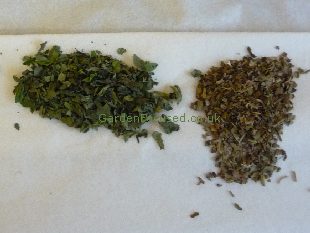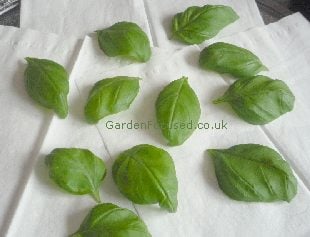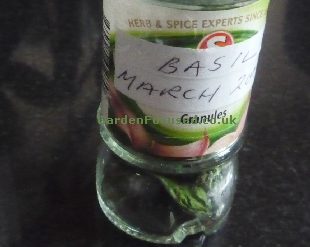FOUR WAYS TO DRY YOUR BASIL
Article by David Marks
Freshly picked basil basil is always the best way to enjoy this herb but not all of us can keep a living plant on the windowsill throughout the winter. That’s where dried basil comes into its own. It’s convenient, flavoursome and drying it can take less than an hour or up to four weeks depending on which method you use.
Our favourite method of drying basil is to microwave it. This is by far the fastest method and we believe it retains more flavour than the other methods. But everyone has their own preferences and that’s why we describe how to air dry it (up to four weeks), dry it on a radiator (about two days) and how to dry it in the oven (a day).
Before we go into detail about those methods however, it’s worthwhile comparing the quality of shop bought dried basil and basil you have dried yourself. Have a look at the picture below and see the difference in colour between the micro waved basil on the left and shop bought basil on the right. The home dried basil is a vibrant green compared to the dull brown shop bought version – click the picture to enlarge it and see difference even more clearly.. A simple comparison between the aroma of the two gives similar results, the shop bought basil is relatively dull compared to the home dried one.

Home dried and shop bought dried basil.
DRYING BASIL IN A MICROWAVE
This is our preferred method because it is quick and preserves the maximum flavour and aroma of the fresh herb. If you compare air-drying to micro wave drying it’s clear that leaving herbs in the open atmosphere for a week or two is a sure way for them to loose a good portion of their taste and aroma. Microwaving for short periods of time on the other hand neither cooks the herb leaves nor does it leave them open to atmosphere for long periods of time. Try it for yourself and you will be able to see and smell the superiority of micro waved herbs.
To pick the leaves simply pinch them off at the base of each leaf. Depending on where you grew the basil you may need to rinse them in cool water to remove any grit or deposits on the leaves. Dry the leaves of excess water by placing them on a paper towel. Place a tissue or kitchen towel over a microwave safe plate and place the leaves on it.
Microwaves vary in their power so proceed in 30 second stages, checking the basil to see when it fully dried. If the leaves bend without starting to crumble then the leaves need a bit more micro waving. Ours take about three minutes on full power but we do check every 30 seconds or so. Small leaves will dry out quicker compared to larger leaves so remove those if they are dry and micro wave the larger leaves slightly longer. Keep a careful look at the microwave while you are doing this to avoid the possibility (it’s never happened to us) of the leaves or paper catching fire.
All that’s required now is to store your dried basil. We use old herb bottles to do this but if you have lots of it a jam jar will hold larger amounts. Make sure the container is thoroughly washed and that it is 100% dry. Place the leaves, unbroken if possible, in the jar, seal the lid and store in a dry, cool and dark place as you would with any other dried herb. Stored correctly dried basil can be kept for a year or more.
DRYING BASIL ON A RADIATOR
This method can be used without any cost as long as you are using radiators in the house. It produces high quality dried basil in about a day’s time. The principle is the same as oven drying basil as described below but you use the heat from a radiator. Picking the basil leaves is exactly as described in the microwave method above, then place them in a bowl or on a plate so that they are separate from each other and not touching.
All the safety rules for placing things on radiators must of course be obeyed (health and safety rules of course!). Exactly where and how you place the bowl / plate on top of the radiator depends on how hot it is. Ours gets reasonably hot at times so we place a back warming bean bag (anything which wont catch fire will do) on the radiator and then place the plate on that.
Leave the plate there for a day or so until the basil is dried and easily crumbles when rubbed gently between two fingers Hey presto, you now have dried basil which can be bottled and stored exactly the same way as for the micro waved basil.
HOW TO DRY BASIL IN AN OVEN
Drying basil in an oven gives good results but of course you will need to have the oven on for a period of time simply for this task which costs money. Place the basil leaves on a clean oven proof tray and place them in the oven. Turn it on to its lowest temperature and leave it like that for 30 minutes then turn off the heat. Leave the door shut and let the leaves dry out for 10 hours or so. It’s important not to turn the oven up high because this will burn the leaves and give them a bitter taste.
Ovens are a bit unpredictable as far as temperature goes, so you will need to test the leaves at the end of the process by rubbing them gently between two fingers. If the leaf crumbles it’s fine to use, if not repeat the process until the leaves are dry. Store the dried leaves as described for micro waving above.
AIR DRYING BASIL LEAVES
This is the traditional method for the amateur gardener to dry basil and although we fully support traditional methods, it’s the least preferred one for us. It can take up to four weeks for the leaves to dry out fully and there is always the danger (with my bad memory anyway!) that they will be forgotten and only discovered when al the aroma and flavour has evaporated into fresh air. The other danger is that mould can infect the leaves before they are fully dried out.
The method of cutting the basil leaves is slightly different from the above three methods. You need to harvest individual stems which have four or more basil leaves. Tie three or four stems together with thin string, Now the important part, you need to find a place in your house which has some light getting into it but not direct sunlight. It also needs some air circulation and to be cool but not cold.
Tie some string up so that it straddles two points and will not be in the way for the next three or four weeks. Hang your bunches of basil from the string and leave them to dry for at least two weeks until they crumble when rubbed between two fingers. It may take up to four weeks for the leaves to dry completely depending on the conditions.
When they are dry store them in an airtight jar. When you want to use the dried basil simply hold a stem and crumble the basil leaf away.
END OF ARTICLE


